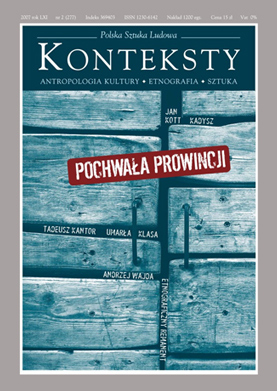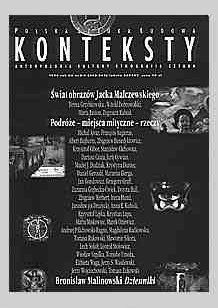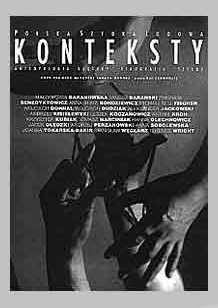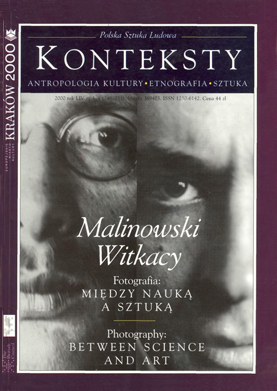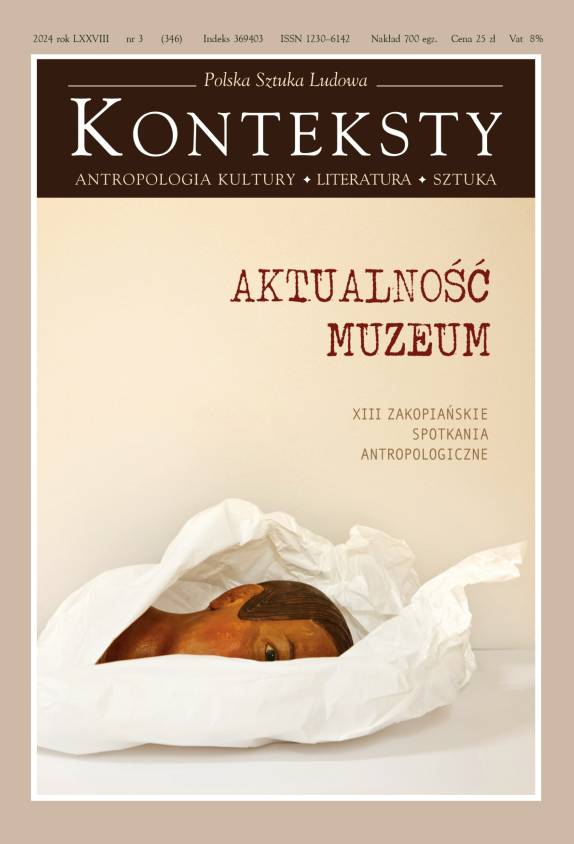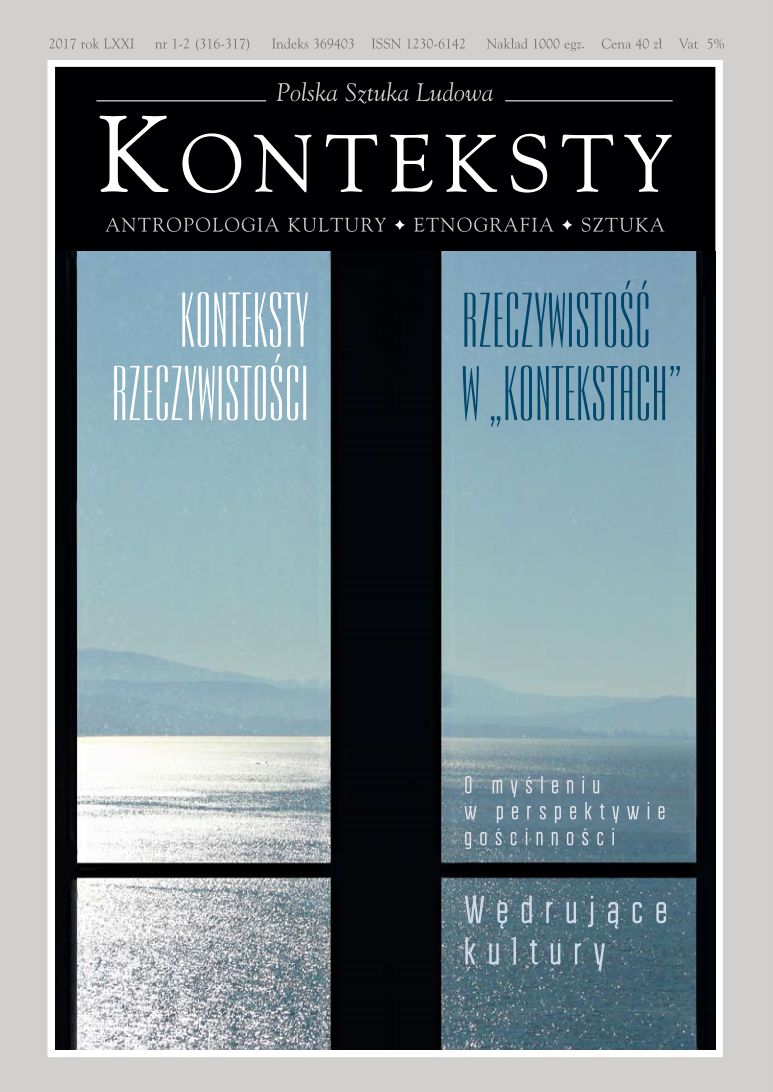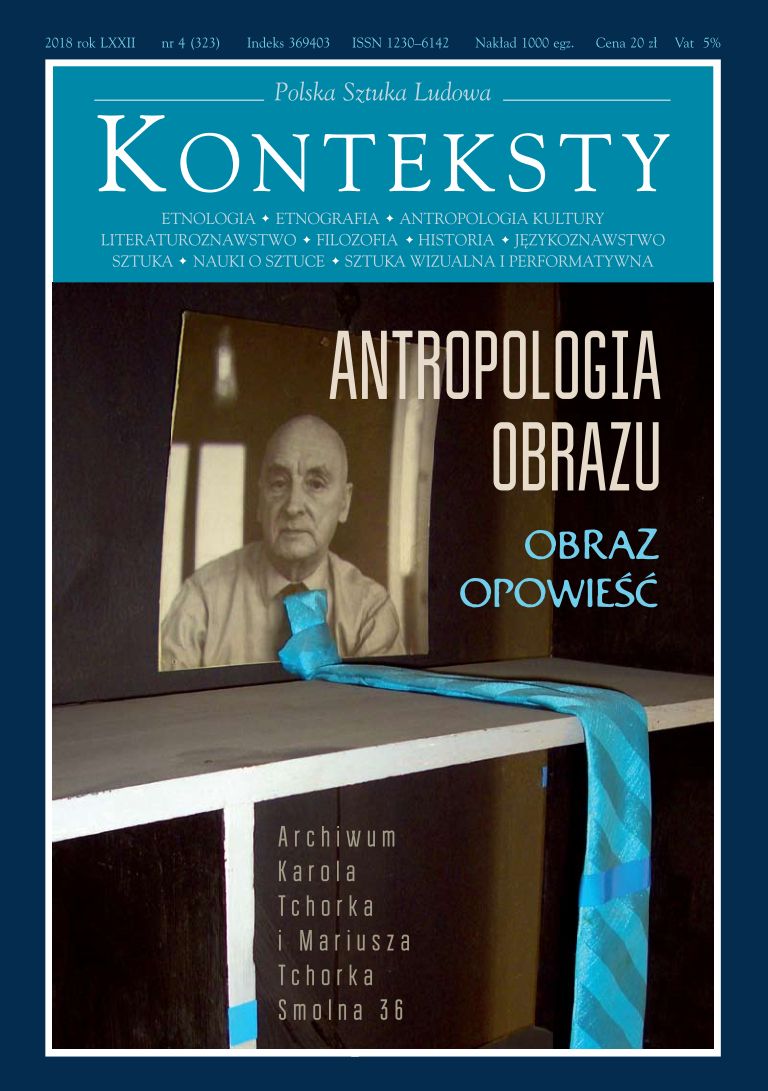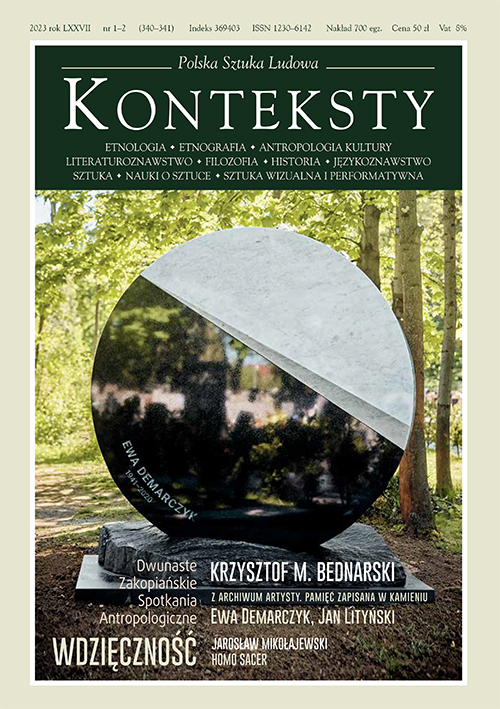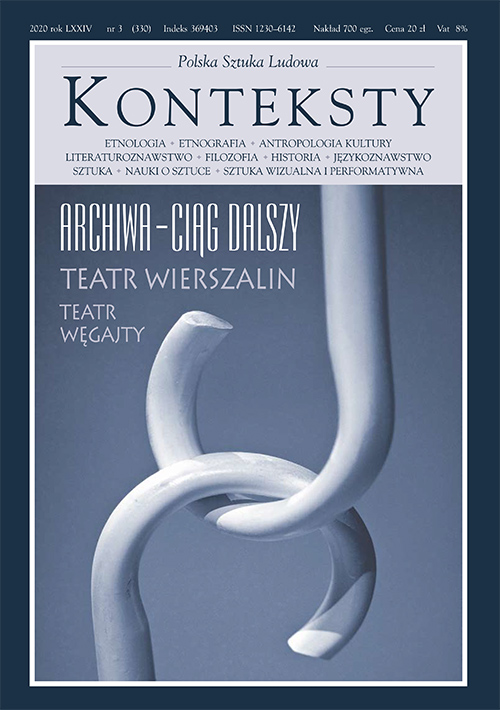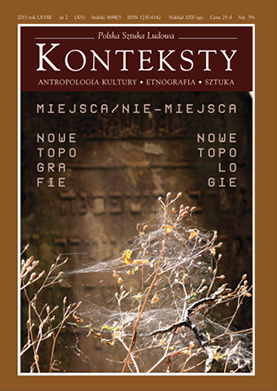Issue 2006/1 (272) - Konteksty

| Wojciech Michera | 2 | |
| Alain Schnapp, Francois Lissarrague | Greek Paintings or Greece , the Land of Painters?  | 3 |
The first part of the article presents the history of nineteenth — and twentieth-century research into the history of vase paintings, the questions dominating in particular periods, and interpretation keys, focused either on meaning or formal-aesthetic aspects. Next, the authors discussed in detail their own premises concerning the exploration of the world of the images found on Greek vases, the identification of series (variants, departures, rules), the definition of sets of paintings, and an analysis of the painting (frame, time). Such an analysis of the iconic system is to result in establishing the social imagery and manner of perception applied by the Greeks. The second part of the text is an example of the realization of the aforementioned premises, and consists of an all-sided analysis of the motif of the fallen warrior, carried off the battlefield by his brother-in-arm. | ||
| Cynthia Klestinec | Vesalius and the Print Culture: Public Dissection as Intimate Ritual  | 15 |
Published in 1543, Andreas Vesalius’s De humani corporis fabrica contains one of the most celebrated and debated images of human dissection. The frontispiece features a large audience around Vesalius himself, who demonstrates the reproductive organs from the uterus of a recently dissected cadaver. Rather than see the image as a reflection of Vesalius’s modern or humanist approach to the study of anatomy or as a reflection of an actual public dissection, this essay argues that it is a response to academic debates about the discipline of medicine and to the threats and demands of print technology. Rather than celebrate print for its ability to disseminate his findings, Vesalius seeks to engineer an atmosphere of intimacy around his book. He describes the medical community as a guild, transmitting an embodied form of knowledge and practicing (almost effortlessly) the manual art of dissection. And the frontispiece reconfigures public dissection as an academic ritual in which the homosocial organization of the medical community is thematized as internally active and intimate. In the frontispiece, the public scene of dissection becomes a powerful ritual, capable of reconciling the tactile techniques of dissection with the distanced readership of the book. | ||
| Jonathan Simon | Invisible and Visible Technology. The Anatomist, the Corps and the Public  | 25 |
Gunther von Hagens’s popular ‘Body Worlds’ exhibition has raised a number of issues concerning not only the ethics of presenting real human cadavers in public spaces, but also the question of whether the work of anatomical preparations is art or science. Here, I compare the work of this modern anatomist with that of his eighteenth-century forebear, Honoré Fragonard. While both anatomists share the virtuosity that is the hallmark of the successful showman or teacher, the two centuries that separate them give very different meanings to their preparations. Fragonard operated in a society where scientific spectacle was a leisure activity for the well-to-do, as well as a teaching tool for certain professional bodies, and where death was a relatively common event to be managed by the church and the family. Von Hagens exhibits bodies in spaces unsanctioned by the medical profession, and is seen by critics to cater to the profane, offering titillation under the guise of education to those who encounter death constantly in the media but rarely outside. Thus, although they are both composed of human anatomical preparations, I argue that von Hagens’s and Fragonard’s collections are as different from one another as our modern medicalized, high-tech. society is from French society in the second half of the eighteenth century. | ||
| Anna Wieczorkiewicz | The Baboon-Woman, the Bear-Woman. The History of Viewing Julia Pastrana  | 40 |
The point of departure is the life of Julia Pastrana, an unusually hirsute Mexican woman who during the second half of the nineteenth century was exhibited as a freak, the missing link, or the Ape Woman, and who also attracted the attention of men of science. Her biography provides us with insight into the nature of viewing people endowed with bodies contrasting with the norms recognized by society. Their public display is interpreted as a phenomenon associated with the social approach to a basically ambiguous fascination with situations in which „obvious” cultural divisions into human and animal, female and male, primeval and civilized, or living and dead, have been crossed. The latter motif is brought to the forefront by an analysis of the fate of the mummified mortal remains of Julia Pastrana, on show up to the 1970s. The article also reflects on the tension emergent between the domains of entertainment and science, treated as mutually inspiring. | ||
| Wojciech Michera | The Complex of Echidna. The Visual Beast  | 47 |
In the medieval commentaries on Genesis 3:1 and in the art of the 13th–17th century, the Edenic tempter is often visualized as having a maiden’s face. The author argues that this feminization of the serpent means that the sin is defined as a „representation”. In Part I, the author examines the late ancient discourse on the evil. Plotin, who identifies the evil with the matter as the non-being – intelligible only in the „bastard” way (gr. notho) – metaphorizes it as the „femininity”: he reminds the comparison of Aristote (Phys. 192a), and the Plato’s’ figure of Poverty (Penia) (Conv. 203). The Platos’ story is associated by Orygenes and Eusebius with the Genesis words. They identify Penia with the Edenic serpent, in such way defining Eva’s status: her being is understood as „lack”, privatio, perceivable only by looking awry, thanks to the serpent which is the bastard cognitive instrument. In Part II, the author examines the formulations of medieval exegetes: similia similibus applaudunt and similitudo mater est falsitatis. The sin as seduction means here: (1) the rhetoric language feminization (the corruption of the primar lingua humana by opening the ability for verbal deceit) and (2) deceptive similitude, which not relates (referre) to the truth of the prototype but closes the image in the mirror feedback. The whole contribution is closed by some observations about the medieval misogynism (a woman as senses and symptom of the man). | ||
| Jaś Elsner | Seeing and Saying: A Psychoanalytic Account of Ekphrasis  | 68 |
The author theorizes about the psychodynamics of ekphrasis, exemplified in the Imagines of Philostratus and in Lucian’s Imagines and De domo. First he explores Freudian dynamic structure of tendentious jokes as a model for ekphrasis. In the jokes the desired object of the smutty conversation between two men (i.e. the female Other, like the picture in ekphrasis) is simultaneously exposed and occluded. Then he explores a Lacanian model for viewing analyzing the ekphrastic, complex role of a gaze as an autonomous object, in the field of desire. In the last section the author studies the dynamics of desire in the vague relation between the world of the picture and the viewers’ „reality” as well as the position of a speaker – both in Freudian and Lacanian terms. | ||
| Katarzyna Murawska-Muthesius | Cartoon-work  | 82 |
Caricatures and cartoons, an established technique of both the ‘overloaded’ and ‘liberated’ image, constitute an especially relevant medium for the studies on visuality and the mechanisms of representation. Although traditionally perceived as ‘weapons’, the instruments of social and political interventionism, caricatures and cartoons have been demystified as ‘sermons’, the tools of policing the established regimes of truth. This article looks at various approaches to studying cartoons, borrowed from semiotics and psychoanalysis. For John Fiske, cartoons, which combine the complexity of the signified with the alleged simplicity of the signifiers, offer a good opportunity to study the processes of visual signification. For Freud and, subsequently, for Ernst Kris and Ernst Gombrich, caricatures and cartoons, comparable to jokes and dreams, are vehicles of aggression and act as manifestations of the unfulfilled wish repressed in the unconscious; they adopt the technique analogous to dream-work, revealing their latent content by obscuring it through the process of condensation and displacement. Referring to both of those methods, the article examines a cartoon about the Solidarity revolution, which was published in „The Independent” in January 1989, and was discussed by Gombrich in August 1989 as an example of the upholding strategy rather than the subversive power of cartoons which ‘like other ritual acts, exist to renew and reinforce the ties of common faith and common values that hold a community together’. I wish to argue that, ultimately, Derrida’s method of focusing on the seemingly incidental details repressed by the authors makes it possible to deconstruct not only the manifest content of the cartoon-text, but also that of its interpretation by Gombrich. Both of these texts repress a latent anxiety of the British subject faced with the destabilization of the post-WWII episteme, leading to the abolition of the Cold War hierarchical binaries. | ||
| Łukasz Zaremba | Venice – Kinshasa. Invisible Towns  | 89 |
The article deals with the institution of the exhibition and, quite possibly first and foremost, with the manner of „displaying” (representation), characteristic for this institution as well as reception and comprehension, closely associated with it, whose range transcends far beyond museum walls. Similarly to the map, the museum constitutes a point of departure for further reflections about perception (the gaze). The opening part of the text is an attempted analysis of the phenomenon of Venice , a city in which the map and its characteristic manner of comprehending reality are defeated in a confrontation with an „alien” town. Venice resists all attempts at being thrust into a framework, and the image of the town is incapable of concealing the city itself, thus demonstrating the artificiality and imperfection of a conception in which the introduction of order consists of imposing an external structure upon reality, and representations become more important than the objects themselves. The next part of the study – remarks about museum strategies and the essence of exhibitions – is a preface to the most important fragment about an exhibition ( Kinshasa . The Imaginary City) featured in the Belgian pavilion at the Ninth Venice Architecture Biennale. The display – the work of anthropologist Filip De Boeck, photographer Marie-Françoise Plissart and curator Koen Van Synghel – shows an image of Kinshasa without actually presenting its buildings, but focusing primarily on the people (in this city, De Boeck claims, bodies comprise the main construction material of the architecture). The exhibition is an anthropological analysis of the social changes which have taken place in the capital of the former Belgian colony in the course of the last fifty years. The show constitutes a complicated entity, in which particular components (the book by De Boeck, the photographs by Plissard, films and interviews) cooperate in order to show a highly unusual portrait of a city. | ||
| Aleksandra Melbechowska-Luty | Harmonia mundi. Several reflections on the Imagery of Stanisław Fijałkowski  | 100 |
The retrospective exhibition of paintings, drawings and graphic art by Stanisław Fijałkowski, held in 2003 in Poznań , Wrocław and Warsaw , brought the public closer to the oeuvre of this acclaimed author, already regarded as a classic of contemporary art. Fijałkowski, born in w 1922, studied at the State Art Academy in Łodź in 1946-1951 under L. Tyrowicz, S. Wegner and W. Strzemiński , his master. Influenced by the avant-garde tradition of the Łódź milieu, he rapidly transcended its conceptions and established the principle of his own creativity, based on an individual perception of the world and excellent philosophical and theatrical training. For years, Fijałkowski sought inspiration in the resources of world cultural heritage, benefiting from the theory of archetypes formulated by C. G. Jung, philosophical thought, the science about symbols, anthropology of culture, literary imagination, mythology, Judaeo-Christian tradition, the symbolic of numbers, elements of Far Eastern spirituality, and the art of his great predecessors: Expressionists, Surrealists and Constructivists, i. a. V. Kandinsky, whose texts: Point,Line and Surface and On the Spiritual in Art he translated. Fijałkowski’s abstract art is suffused with meaning and based on the subconscious, the intuition, the imagination, the spiritual experiencing of all phenomena and the symbolic „prototypes of form”. The distinctive trait of his compositions consists of an unusual repertoire of plastic „signs” such as circles, spheres, triangles, cubes, ellipses, cylinders, cones, arches, strips, figures, fields of dots and lines, as well as the heads, profiles, wings and outlines of angels, and thus geometrical and biomorphic forms, always subjected to rhythms, inserted into smooth surfaces or vertical, horizontal and transverse divisions, which act as the construction core of his compositions. The most outstanding works include Paintings for Waleria (the artist’s wife), brimming with „colourist sensitivity”, Talmudic Studies, Highways (metaphors of spiritual „elevation”) and compositions commemorating Solidarity and dealing with the motif of the martial law period in Poland during the early 1980s. The author employs various graphic techniques, including woodcut, etching, aquatint, lithography, and linoleum block printing, which serve as an excellent means of expression; he is just as successful in applying computer graphics. Fijałkowski always supports the „open form” of his works which enables them to be constantly supplemented and rediscovered by the imagination of the viewer, based on the latter’s own associations. | ||
| Yannis Papadopoulos | Wild Animals – the Theatre – Gods. Plato’s „Virtue” and Aristotle’s „Golden Mean”, or Classical Theses about Ethics and Politics, or Antitheses about Mimesis  | 110 |
An analysis of the Platonian concept of virtue, Aristotle’s „golden mean”, and the role played by them in moulding the socio-political reality of Greece. The author ponders on the place assigned to man in the conceptual structure spanning between two extremities defined as „wild animals” or „gods”. Within this context he reflects on the social function of politics, which in its capacity as an ideological yardstick and a practically applied virtue defines the conditions of the relations between itself and the other arts, the most prominent being mimesis and tragedy. | ||
| Szymon Wróbel | Casting Spells on Representation  | 119 |
Where should one seek the archaeological sources of the representation system? Are those skills embedded in our behavioral and even emotional functioning since in accordance with the suggestion formulated by Freud sources of human symbolism should be sought in defensive mechanisms which allow us to deal with the first painful wounds inflicted against our narcissism? In the beginning there was the sexual drive, and representation appears to be its mere perception; on the other hand, since in das Es we encounter only representations of the drive and not the drive itself, then the life of representation seems to precede that of the forces of the drive. Or should we look for the origin of human symbolism in linguistic systems, i. e. in the ability to produce an endless sequence of sentences and to refer it to the world, as has been suggested by Chomsky? The basic purpose of this study is to attempt answering the above posed questions and, consequently, to confront the psychoanalytical and cognitivistic discourse. The author claims that the superiority of the former discourse consists predominantly in the fact that it tries to understand the root of representation avant la lettre, i. e. to comprehend the essence of representation before it started to fulfill orientation (representation) functions vis a vis the outer word. Moreover, S. Wróbel maintains that the fundamental paradox of the human representation system consists in the fact that representation, whose initial yardstick is escape from the world of drives, is to become an appliance whose measure is adequacy. Representation, whose initial function was prolonging the existence of forces more powerful and primeval than itself (i. e. drives), is to become a depiction of something that is diametrically different from it and ontically totally alien, in other words, the outer world. Representation was the outer quality of the world of nature (the body) in the psychic apparatus; it is to become an inner simulation of the outer quality (nature) in the same apparatus. Hence the possibly hasty but indispensable conclusion that representation is a fold, a knot, a bow, a stratification, a crisis, and a meeting point of elements of the natural world, albeit experienced from two sides: the body and the world. That what we call an interior (representation) is only the outcome of a collision of two tectonic slabs in the world of nature: the physics of the outer world and the biology of the corporeal world. Only such a geographic location of representation in the world allows us to reconstruct the contents of this conception. | ||
| Zbigniew Osiński | The Works of Jerzy Grotowski as a ”Research Subject”  | 132 |
This text emerged gradually in the course of several years. Its consecutive stages were composed of my speeches at conferences and symposia dedicated to Jerzy Grotowski: in Moscow (»International Forum on Theatre Education and Experiment» during the International Theatre Olympics, May 2001), Pontedera in Italy (»Jerzy Grotowski. Primo Tempo: Il Teatr Laboratorium tra Opole e Wrocław 1959–1969. Le energie della genesi – Testimonianze» [Jerzy Grotowski. The First Period: Laboratorium Theatre between Opole and Wrocław 1959-1969. The Energies of the Beginning – Testimony] as part of the «Passato e presente di una ricerca (2001–2003)» project, October 2001), Brzezinka near Oleśnica in the environs of Wrocław (»Jerzy Grotowski. Paratheatre 1969–1978. Theatre of Sources 1976–1982» in the course of the «Passato e presente di una ricerca. The Past and Present of a Certain Search» project, 27–29 September 2002), in Munich (Unser Theater-Kulturzentrum, 22–23 October 2003), at Université de Paris – Sorbonne ( Paris IV) – during the international «Revisiter Grotowski» colloquium organised by the University and Centre de civilisation polonaise at the time of the Polish Season in France : «New Poland . Une saison polonaise en France » (Amphithéatre Guizot, 5 June 2004), in Wrocław – in the course of the «Grotowski. Memory, Repetition, Discontinuity» symposium as part of the XIV Session of the International School of Theatre Anthropology (Na Świebodzkim Theatre, 9 April 2005), and in Rome – at the «Jerzy Grotowski. Essere un uomo totale. Tavola rotonda «Grotowski traccia il cammino ancora oggi?», mostra e presentazione del libro» conference (»Jerzy Grotowski. Being a Complete Human. Round Table «Does Grotowski Still Define Routes?», exhibition and book presentation » [Istituto Polacco – Polish Institute, 17 December 2005]). The joint feature of the various topics of the meetings and speeches was composed of the «subject» of the reflections (the works of Jerzy Grotowski) and my attitude as a researcher. The latter underwent assorted changes and evolutions, but certain themes and motifs remained relatively constant. I consider this text to be a sui generis summary of my more than half a century-long adventure with Grotowski and his oeuvre. Obviously, this abridgment has been performed from a present-day perspective, here and now. For many people, particularly those considerably younger than myself, Grotowski was, and remains primarily a «spiritual master», a sage and a guru, while others consider him to be an outstanding politician and strategist who managed to successfully tackle even the most difficult circumstances. Personally, I regarded Grotowski from the very outset as a great artist, which he remained throughout his entire life. Would we be discussing Grotowski, however, if not for his theatre achievements, those several plays which have become part of world theatre history: Akropolis (Acropolis), Tragiczne dzieje doktora Fausta (The Tragical History of Doctor Faustus), Książę Niezłomny (The Constant Prince), or Apocalypsis cum Figuris? And does the other reason not lie in his rank in the art of the theatre, achieved primarily thanks to productions dating from the 1960s? Let us also not omit the fact that if it were not for the theatrical stage in Grotowski’s life all his subsequent experiences and eventual artistic efforts would have assumed an entirely different form. There is no one way of experiencing Grotowski’s accomplishments, nor is there an exclusive truth about him. No one can claim the right to a monopoly: neither the Workcenter of Jerzy Grotowski and Thomas Richards in Pontedera, nor the Centre for Study of Jerzy Grotowski’s Work and for Cultural and Theatrical Research in Wrocław , which I have co-founded and in which I have worked for fifteen years, nor any other institution or person. Lastly, I call for care, patience and the avoidance of all «shortcuts», since the only thing of which I can be certain is my firm conviction that in this case all shortcuts are a mere mirage. | ||
| Katarzyna Barańska | Home – the Road to Supraśl  | 158 |
The text originated from a selection of recorded interviews conducted with Maria Parczewska and Janusz Byszewski from the Creative Education Laboratory at the Centre for Contemporary Art in Warsaw . The conversations concerned the „Home – my centre of the world” art project realized in Supraśl in September 2003. The prime organizer was the Polish Culture Institute at Warsaw University , with the British organization The Public as an important participant. The author presented the most prominent motifs of the projects, its goals and structure of activity, and explained the motives for selecting the locality and the manner of realizing the theme. The attempts entailed reconstructing a vision of a home in Supraśl and its implementation, as well as building bonds between the participants of the undertaking, overcoming distrust and stereotypes, and creating a new reality and festivity. | ||







